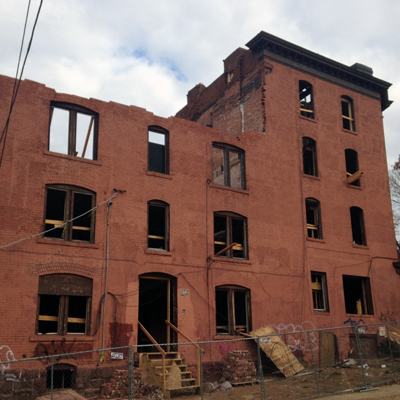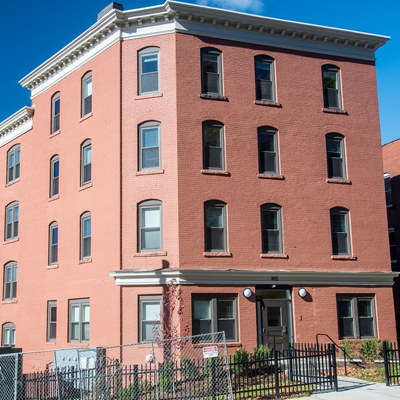Image

In the late 1800s, Hartford, Connecticut, was dubbed "America’s richest city" because of the per-capita wealth of its population. It attracted writers such as Mark Twain and Harriet Beecher Stowe. A booming financial center, Hartford was a leader of America’s industrial revolution. Nowhere was this more evident than in the Frog Hollow neighborhood, named for the frogs that inhabited the banks of the Park River.
Both Underwood and Royal typewriters were built in Frog Hollow. In addition, industrialist Albert Pope built his namesake manufacturing company there, producing what became the Columbia bicycle, as well as the Pope automobile (the truly original Pope mobile).
The abundance of manufacturing jobs attracted immigrant workers from all over the world, and with them came a demand for housing. In Frog Hollow, this demand spurred the development of an architectural style known as "perfect dix"—a three-story brick structure with large bay windows in the front and two identical apartments on each floor.
However, by the late 20th century, many of these historic homes were in disrepair and abandoned. Residents had left for the suburbs and gang violence in the neighborhood made national news.
In 1989, Mutual Housing Association of Greater Hartford (MHAGH) embarked on what would become a 30-year commitment to restoring Frog Hollow. With assistance from NeighborWorks America and the state of Connecticut, MHAGH purchased seven perfect-six structures along Park Terrace, a major thoroughfare flanking Pope Park, which had been donated by Albert Pope and designed by the renowned Olmsted brothers as a gift to the workers in his factories.
Although MHAGH only had enough funds for a moderate renovation of the property, Park Terrace stood out as an oasis of calm amid a sea of abandonment and chaos. Residents joined together to protect their property from the gang violence so prevalent around them. MHAGH committed to continue investing in the neighborhood and purchased 19 parcels, preserving 12 more historic structures and building one new building on the adjacent block.
 In 2007, MHAGH tackled the block behind Park Terrace. The buildings were beyond saving; one actually collapsed prior to its scheduled demolition. The resulting Zion Street Mutual Housing project won an award from the Hartford Preservation Alliance, even though it was new construction, because it reflected the character of the neighborhood’s architecture.
In 2007, MHAGH tackled the block behind Park Terrace. The buildings were beyond saving; one actually collapsed prior to its scheduled demolition. The resulting Zion Street Mutual Housing project won an award from the Hartford Preservation Alliance, even though it was new construction, because it reflected the character of the neighborhood’s architecture.In 2016, MHAGH made its largest investment yet in the neighborhood with the renovation of the original Park Terrace and the creation of Summit Park, consisting of six buildings abutting existing investments in the neighborhood. Through these two projects, MHAGH renovated 84 apartments and four commercial spaces in 13 historic properties. More than 20 sources of financing were used, including a variety of tax credits, state grants and funding from both NeighborWorks America and NeighborWorks Capital.
Although great attention was paid to the many historical features of these buildings, MHAGH incorporated modern amenities. Six of the buildings have solar photovoltaic panels and every building has a high-efficiency heating system. To reduce long-term operating costs, hardwood floors and granite countertops were installed instead of carpeting and laminates. The new developments provide affordable homes for families, seniors and people in need of supportive housing.
Along with preserving Frog Hollow’s past, MHAGH is creating opportunities for its residents. The nonprofit offers leadership training, financial counseling, and educational and job opportunities.
Over the last three decades, MHAGH has invested more than $40 million in a four-block area of Frog Hollow, and another 86 housing units are in the pipeline. It is carefully restoring a part of Americana for the future, one building at a time, in collaboration with its residents.

